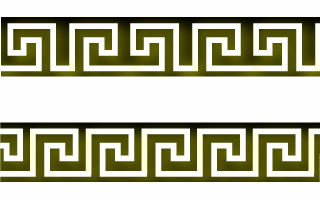You can see it in the picture above, but it may not be immediately obvious. It is in fact known as a Greek Key. The Greek Key was one of the most important symbols in Ancient Greece, representing infinity or the eternal flow of things. Many temples and objects were decorated with this motif, and it is considered that there is a connection with the Cretan labyrinth – indeed - a labyrinth can be drawn using a Greek key.
It also symbolizes the bonds of friendship, of love and devotion and that’s the reason it’s often given as marriage gift. It can symbolize as well the four cardinal points, the 4 seasons, waves – especially in the round version of it, or snakes, among other things.
In this blog we continue our cellar to shingles series about the building of the library and celebrate its recent listing on the National Register of Historic Places. We hope that you will use these blogs as a guide to exploring and enjoying all the little mysteries designed into the building's construction and decoration.
In a previous blog we explored the classical motifs carved in stone on the Conway Public Library’s exterior. Those motifs were echoed in copper on the library’s roof and clock tower (more on this in a future blog) and the library’s interior woodwork. For now we will focus on the Greek Key motif. There are a wide number of minor variations but in general it can be seen as a rectangular repeating design that flows without beginning or end.
Don't see the Greek Key yet? Let's meander around and search for some clues. If you go into the "red" founders room seen in the first picture above you will find a set of framed photos detailing contributions made in the library's construction. One of the photos and captions record that Ephraim C. Smith of Boston was the "Maker of the reading room mantle-piece, tables, delivery counter, seats, and switchboard closet." The switchboard closet seen below is now obsolete and empty, ...
...but if you look below it you can see a good example of the Greek Key motif.
A closer look at the motif shows that instead of being carved out of a single piece of wood, it was in fact sawn out with a jigsaw and then applied with small nails.
The Greek Key is also known as the meander motif which took its name from the River Meander in ancient Greece (present day Turkey). The Meander was characterized by a very convoluted path and is also the source of the verb meander.
We have our own version of a meandering river in the nearby Saco. The picture below is a detail of the map on the wall seen in the first picture above.
So to learn more about the hidden codes and secrets at the Conway Public Library visit us at the Henney History Room.






No comments:
Post a Comment